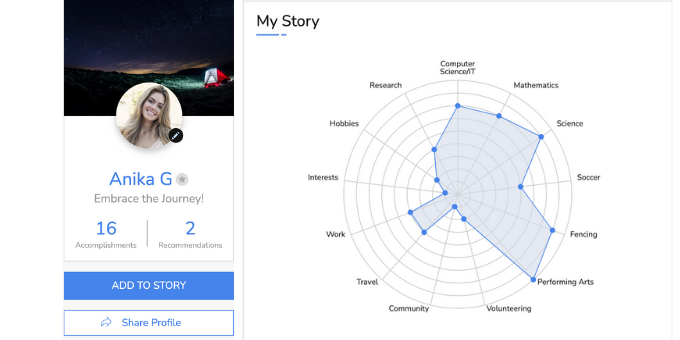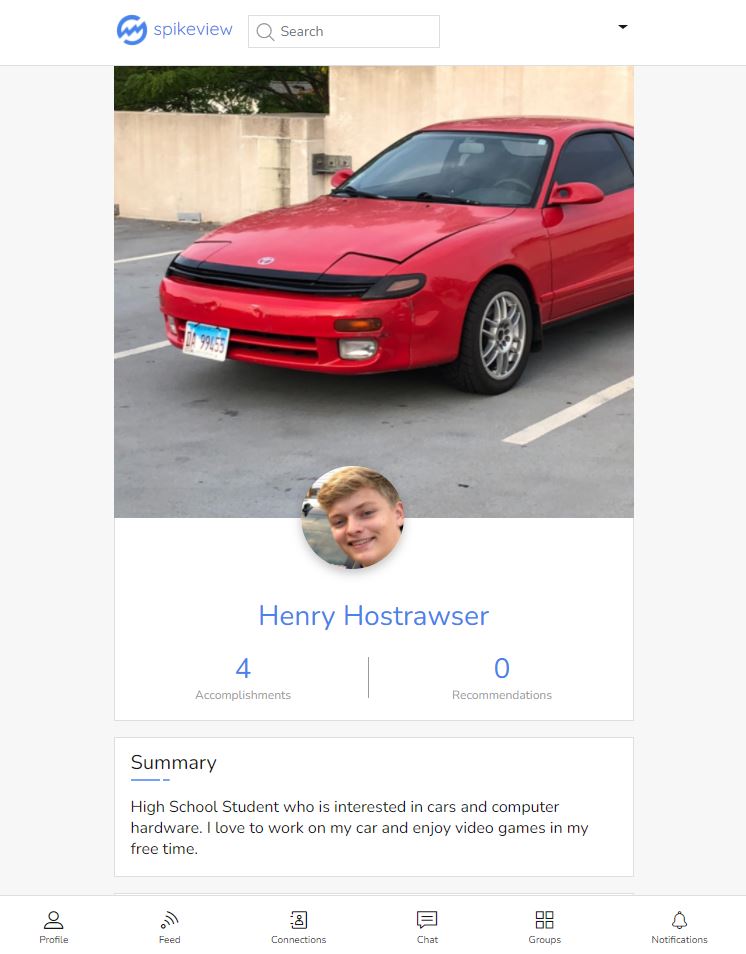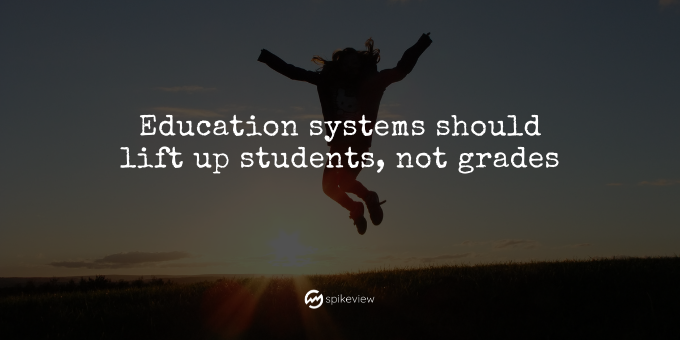Education systems should lift up students, not grades
This post by Peter Hostrawser was originally published by Teachers Going Gradeless, and has been reposted with permission.
“Mr. Hostrawser, how do I get my grade up?” That’s something I hear regularly for over 20 years as a business educator in high schools. There’s nothing that makes me more disappointed when a student asks me that. I’m not mad at the student, I’m mad at the system.
Today’s education system uses numbers to control the lives of students and teachers. Young people don’t go through school seeing themselves as individuals. Parents tell other parents things like “she made the honor roll” or “he’s not quite straight As, but he’s working on it.” GPA and test scores become a foundation for conversation whether we realize it or not – and our kids pick up on it.
When an adult asks a teenager how school’s going, the teen isn’t going to talk about what they’ve learned or some profound connection they made between curriculum and the real world. It’s always about the GPA. As a teacher, I think that’s absolutely ridiculous. I’m in this profession to help young people prepare for life in the workforce, not give them marks that indicate successful regurgitation of memorized material.
In my own life as a student, there are only a few moments that I remember being pivotal in my education. How successful was my education if all I have to show for it is a high school GPA and college diploma? Was I equipped to stand out from the crowd, or getting a certificate to honor conformity to the system? That’s the biggest problem with grading. It’s a number that becomes an ending to the educational journey. A marker to judge a student’s worth and potential.
My concerns about the modern educational system were building up until a few years ago, I attempted to do something about it. I tried having the students in my CTE class build portfolios in public. I’d ask questions like:
- What are the stories that make you you?
- How do your peers, friends, teachers, coaches, and family describe you?
- How do you feel when you’re going through this curriculum?
- How does what you’re learning fit into life outside of school?
I ran into two challenges when I was working with students on creating their portfolios: students didn’t know how to get started, and portfolios were out in the open for anyone online to see. There’s the obvious student privacy concern, but also something longer lasting. Students were afraid to fail in public. They didn’t want to look stupid, so they were timid about the stories they’d come up with in their portfolios. It’s so much easier for them to say “just tell me how to get an A, and I’ll be good.” Get in line with everyone else, hide behind a grade, and pass up the chance to demonstrate their unique qualities.
I’ve been trying to get to a place where students can tell experiential stories that show their value in and out of the classroom. I want them connecting the dots between different subjects, projects and experiences, knocking down silos constructed in our curriculum. Here are two outcomes that I hope to achieve as an educator:
- Students become self-aware, understanding who they are, what their interests are, and how they might impact the world with their unique strengths.
- Students become self-advocates, creating opportunities for themselves as they build a network of peers and mentors.
As I was trying to navigate this new teaching territory, I met Ekta Sahasi, who had developed the spikeview platform. As soon as I saw it, I had to have it. I was looking at the solution to helping students clear a path to success.
I’ve spent too much time researching tools and methods for students to take notes about work, journal about their feelings, and tracking their life journey all in one place. They end up being just random documents sitting in some folder on their computers. From all my research, only spikeview had it all. The centerpiece of the platform is a graphically rich and immersive portfolio, and that’s the key to unlock self-awareness and self-advocacy. Only a student sees their portfolio, until they choose to share it with someone else.
The platform prompts students to think deeper about who they are as an individual – not as a number on a manila folder in a cabinet somewhere. When students add entries to their spikeview, they’re asking themselves:
- What was the unique strength I brought to this team that enabled us to succeed?
- What was it about that experience that made me enjoy it so much? Do I want to participate again?
- How do I feel when I’m able to do something in 10 minutes that takes someone else an hour?
- Would I rather be known as honorable or being on the honor roll?
As students add to their portfolio, the platform automatically generates a “spike chart”, illustrating areas of interests and accomplishments.

It’s not a clunky psychology test or vague career test – it’s a reflection of what the student enters. They’re able to visualize who they are and what makes them different from other students. Ever since I was introduced to Ekta and spikeview, I’ve been introducing it to my fellow teachers and schools across the country.
For students in my classes, they realize that this isn’t another test administered by their teacher or the school. It’s a power they have to become self advocates in their educational journeys. My students realize they have the control to connect with others, tell their personal learning journeys, and build their pre-professional profile on the spikeview platform. This in turn helps me as an educator become more of a coach and mentor and saves me time and energy trying to motivate students.
One of the worst things that can happen to a student is reaching the end of high school, only to know themselves based on a GPA and transcript. That’s why so many graduates end up scrambling and not knowing their path after high school. Those who are fortunate to go to a university are unsure about how to pick a major. They don’t know their own skills, who they really are, what they enjoy and what opportunities they might make for themselves.
There’s no reason this should be the inevitable path for students. They shouldn’t be expected to squander years of their life, stumbling about to see what jobs accidentally present themselves that maybe they won’t hate. Students using spikeview are looking at their journey on a continuum. They see where they have been, can explore what’s next and make informed decisions on where not to spend time. It’s not a snapshot of one class or one reporting period. It’s life, as they know it.
There’s a very personal element to all of this, besides being a classroom teacher. My teenage son has been using spikeview. Let me share a bit about why he’s so enthusiastic about spikeview. First, a few data points to give some context. My son loves cars, working with his hands, and building computers.
He wanted to get a job at a computer store, but he doesn’t have an assertive voice in an interview setting. Like most students, he’s been trained in school to sit quietly until his number is called.
Well, he created a spikeview portfolio. It became a fun project for the two of us – he’d draft stories and I’d look it over and offer comments. He polished it up and shared a link with the hiring manager at the computer store. He got the job! It turned out, my son’s spikeview turned out to be a major factor for him landing the role. The interviewer didn’t have to say “tell me about yourself,” because he already knew. Instead, he could jump right to some specific questions about my son’s experience and joys.

Like any teacher would, I shared his portfolio to my students as a learning opportunity for them. I asked them how they see my son based on his portfolio. They came up with (1) automotive enthusiast, (2) problem solver, (3) good working with his hands, and (4) huge interest in computing.
When I reported that back to my son, it was more powerful than any grade he’d have gotten if this was a school project he completed. He had clarity about himself and his journey. Of course that thrills me, seeing that in my own son. But imagine if your students used a tool as straightforward as spikeview to get clarity about their purpose, their mission, and their opportunities?
As more educators move towards a gradeless future, spikeview is a way for educators to validate learning.
In my career planning courses, students are journaling each week and they have to include a story of what they learned during the week. I still have to check a box because I’m operating within the current system that requires numbers attached to people. But as I give my students feedback on the content of their journals, they know what I’m really doing is helping them strengthen their personal stories. They’re building spikeviews that will help them stand out from the crowd.
Right now, I’m helping them learn to receive comments and critique on their content. They need to be comfortable learning from mentors. It’s so exciting, because these kids are going to be sharing a complete picture of who they are to win scholarships, get small business loans, attend college, or land jobs that fit their interests. Self-awareness and self-advocacy are developing before they even leave high school.
I’ll end with one other amazing aspect of spikeview. There’s a built-in opportunity hub that helps students pursue their passions. Special programs, internships, and even scholarships of all types. Students are able to start building a network on spikeview with peers who are pursuing similar interests, giving them a jump on life after graduation.
I’ve had so much success with students digging into the platform, almost like they’re freeing themselves from the distractions of social media and the internet. They’re able to focus on themselves without it feeling like some kind of dull, self-help project. They’re discovering common threads through their play, school, and work. Students are seeing what they’re all about, and identify the mutually beneficial connections to make on spikeview.
So taking this all back to the problem of our current educational system. In this wonderful internet age, we have ways besides grades to track the learning journey of students. We don’t have to box them according to their ability to memorize notes for a test.
Empower students to tell their own stories, and celebrate them for it. I’m sure you and I both want the same outcomes for our students, and I’m finding spikeview gets them there. Students mature through self-awareness into self-advocacy. I can’t wait to see where this next generation leads us!
I’ll be hosting a teacher workshop to share more. Sign up here if you’re interested.
Peter Hostrawser is “The Unlearning Coach” and host of the Disrupt Education podcast. His passion is to transform people to become energetic learners through personal interest discovery. He helps students overcome their fears and build fulfilling dreams.

